Abstract
Acknowledgements
Finally, I am deeply grateful to my family, as this thesis would not have been possible without them. Special thanks to my parents, Nikos and Maria, and to my sister, Charoula, for their unconditional love, understanding, support and constant encouragement since the day I was born.
Contents
7-1 System outage probability,𝑃outsys, (calculated using Algorithm 7.1) versus the ceiling of 𝑟(the ratio of the traffic demand to the GW capacity).100 7-2 General SOP improvement factor, 𝐼g, (calculated using of Algorithm 7.1), compared to a diversity system consisting of 𝑁 = 5 GWs, against the ceiling of 𝑟 (the ratio of the traffic demand to the GW capacity).
List of Tables
List of Algorithms
Introduction
- Motivation and Scope
- Overview of Main Contributions
- Thesis Outline
Energy efficiency (EE) is a key performance indicator for 5G networks, which is measured in bits/joules and expresses the amount of information that can be reliably transmitted per unit of energy consumed [1,4]. Due to the nonconvex form of the resulting problem, we propose a low-complexity algorithm using sequential convex optimization (SCO) theory.
Bibliography
Schober, “Energy-efficient resource allocation in OFDMA systems with large base station antenna counts,” IEEE Trans. Energy-Efficient Subcontracting Assignment and Power Allocation in OFDMA Systems with Maximum Fairness Guarantees," IEEE Trans. Schober, "Energy-Efficient Resource Allocation in Multi-Cell OFDMA Systems with Limited Backload Capacity," IEEE Trans.
Lu, “Optimal energy-efficient power allocation for distributed antenna systems with imperfect CSI,” IEEE Trans. Jorswieck, “Globally optimal energy-efficient power control and receiver design in wireless networks,” IEEE Trans.
A Framework for Weighted-Sum Energy Efficiency Maximization
- Introduction
- System Model and Problem Formulation
- WSEE Maximization Algorithm
- Extensions to the Proposed Approach
- Systems with Multiple Resource Blocks
- General Power Consumption Model
- Numerical Results
- Conclusion
An alternative approach to overcome this limitation while maintaining high global performance is to maximize the WSEE, defined as the weighted sum of the energy efficiency of the connections [1]. Then, the achievable data rate and power consumption (assuming the power amplifier operates in the linear region) of the 𝑖𝑡ℎ user are given by: 𝑅𝑖(p) = 𝐵log2(1 +𝛾𝑖(p)) and 𝑃𝑐,𝑖( 𝑝𝑖) respectively = 𝜇𝑖𝑝𝑖 +𝑃𝑠𝑡,𝑖, where𝜇𝑖 = 1/𝜂𝑖, with 0< 𝜂𝑖 ≤1 the efficiency of the power amplifier, and 𝑃𝑠𝑡,𝑖 >0 is the statically dissipated power in completely different circuit blocks of the 𝑖𝑡ℎ transmitter and its intended receiver. It is noted that the two problems in (2.6) are equivalent, because in the second problem we omit the constant terms of the objective 𝑓̃︀(v).
Similar observations can be observed in Figure 2. 2, WSEE remains constant when WSEE is maximized, while it decreases with 𝑃max when WSR is maximized due to the higher transmit power required, and 2) and. Finally, we examined notable extensions of the proposed approach to multi-block resource systems and a general energy consumption model.
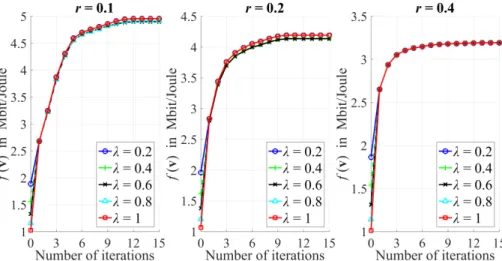
Energy Efficiency Optimization: A New Trade-Off Between Fairness
- Introduction
- System Model and Problem Formulation
- Energy Efficiency Optimization Algorithm
- Algorithm Design and Complexity
- Applications
- Numerical Results
- Conclusion
- Appendix: Sequential Convex Optimization
In what follows, we transform the original non-convex problem (3.2) into an equivalent problem in a more manageable form. Finally, the complexity of Algorithm 3.1 depends on the number of iterations to convergence and on the complexity of each iteration (which is mainly limited by the optimization of a convex problem). Regarding the WM maximization, we cannot directly consider the KKT conditions of problem (3.4) since the objective 𝑓𝑊 𝑀(𝑢, 𝑣) is not differentiable.
However, Algorithm 3.1 converges to a point that satisfies the KKT conditions of the following problem (equivalent epigraph form of problem (3.4)): max. This theorem can be easily proved if we write problem (3.6) in its equivalent epigraph form: max.
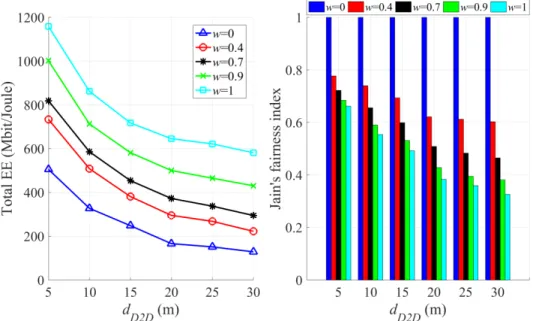
Dynamic Energy-Efficient Power Allocation in Multibeam Satellite
- Introduction
- Problem Formulation and Transformation
- Energy-Efficient Power Allocation
- Numerical Simulations and Discussion
- Conclusion
- Appendix: Successive Convex Approximation
Finally, to remove the non-differentiability of the objective function, we rewrite problem (4.4) in its equivalent epigraph form [10] using the auxiliary variable t= [𝑡1, 𝑡2,. Regarding the required capacity of the users, we assumed an asymmetric traffic distribution according to the linear model: 𝐶𝑖𝑟𝑒𝑞 = 𝑟 𝑖, ∀𝑖 ∈ 𝒩, where 𝑟 is the measured traffic slope. First, we investigate the convergence speed of the proposed algorithm for 𝑤= 0, 10 Mbps/W and different starting points.
Moreover, the complexity of the SCA method, in its general form, has been studied theoretically. The complexity of the SCA method is then 𝒪((𝜉/𝜖)ℎ(𝑛, 𝑚)), where 𝜉 = 𝜓0(𝑥*0)/𝜓0(𝑥*) ≥ 1 and ℎ(𝑛, 𝑚) is the complexity of any convex optimization problem that is a polynomial function of the number of variables and constraints (𝑛 and 𝑚, respectively).

Globally Optimal Selection of Ground Stations in Satellite
- Introduction
- System Model and Problem Formulation
- Equivalent BILP Problem and NP-hardness
- Global Optimization Algorithm
- Numerical Results and Discussion
- Conclusion
To prove the NP-hardness of problem (5.3), the following property is exploited: if a special case of a problem is NP-hard, so is the general problem. Obviously, the NP-hard problem (5.4) forms a special case of the general problem (5.3), and thus we have Theorem 5.1. The proposed B&B method is given in Algorithm 5.2, where 𝑈 is the best global upper bound found by the algorithm so far (𝑔* ≤ 𝑈), and ℒ is the list of active subproblems that controls the order in which the subproblems are explored (a generated subproblem is called active if it has not yet been investigated).
Although the original BILP problem (5.3) is likely to be intractable in the worst case (due to its NP-hardness), the hardest problem cases may rarely arise in practice (due to their particular structure), so the average case complexity may be a more appropriate measure of an algorithm's efficiency. Note that if 𝑀 = poly(𝑇, 𝐾), where poly(𝑇, 𝐾) is some polynomial in 𝑇 and 𝐾, then Algorithm 5.2 will have polynomial-time complexity in the average case.11 Nevertheless, the average-case complexity of the B&B method is very challenging to study theoretically, so we resort to a numerical analysis in Section 5.5.
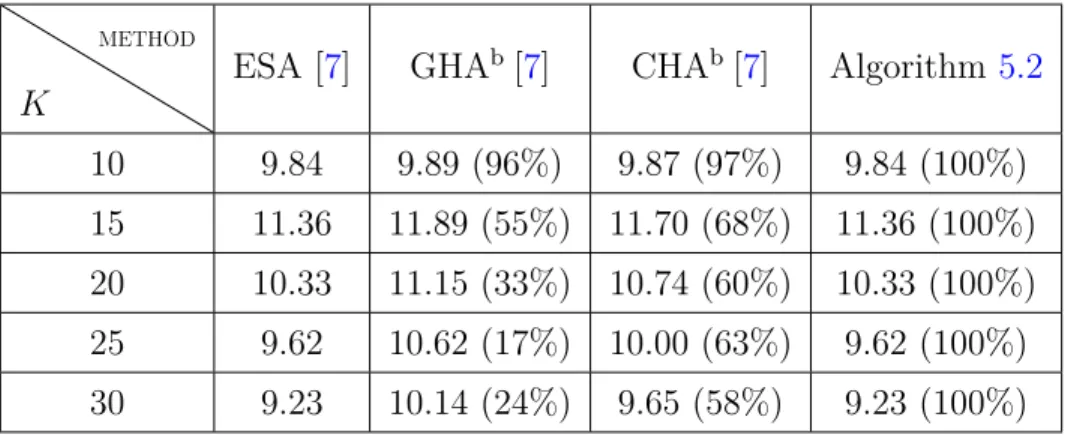
Minimizing the Installation Cost of Ground Stations in Satellite
- Introduction
- Problem Formulation & NP-Hardness
- Global Optimization Using Dynamic Programming
- 𝑅(𝑖, 𝑗) := 𝑅(𝑖 − 1, 𝑗) 13: end if
- Polynomial-Time Approximation Algorithm
- Numerical Simulations and Discussion
- Conclusion
Design of an apolinomial-time approximation algorithm with a provable performance guarantee at the distance between the objective value of the achieved solution and the global optimum (thus achieving a reasonable compromise between performance and complexity). In this section, we study the performance of the proposed optimization algorithms through numerical simulations. 1 illustrates the average setup cost versus failure probability threshold achieved by a) exhaustive search, b) DP (Algorithm 6.1), c) DPAA (Algorithm 6.2) for different values of the parameter 𝜖 and d) basic algorithms.
In this chapter, we have been concerned with the minimization of the installation cost of GSs in RF/optical SatNets satisfying a failure probability constraint. Panagopoulos, “Propagation Phenomena and Modeling for Fixed Satellite Systems: Evaluation of Fade Attenuation Techniques,” in Radio Wave Propagation and Channel Modeling for Earth-Space Systems, Taylor & Francis Group, CRC Press, 2016.
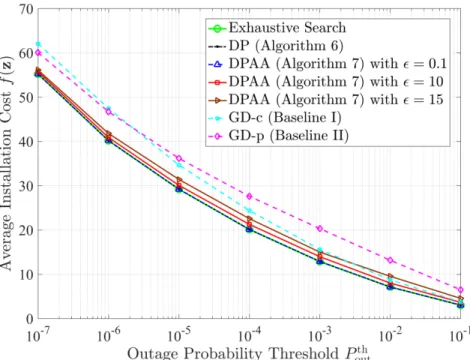
On the Computation and Approximation of Outage
Probability in Satellite Networks with Smart Gateway Diversity 17
Introduction
- Related Work
- Contribution
- Chapter Organization
- Mathematical Notation & Conventions
- Preliminaries on Discrete Probability Distributions
- Bernoulli Distribution
- Binomial Distribution
- Poisson Binomial Distribution
- Poisson Distribution
Next-generation broadband satellite networks require very high data rates (up to 1 Tbps), which can be achieved by using EHF bands (above 30 GHz) in the feeder links. The performance analysis of these schemes is based on a simple probabilistic model that assumes the same outcome probability for each GW (although this is unusual in practice) as well as independent propagation conditions over. In the former scheme, all the 𝑁 GWs are active and each user beam is served by a group of GWs, while in the latter scheme each user beam is served by only one GW and switches to a redundant GW in case of failure.
Furthermore, we study the performance improvement (in terms of SOP) that can be achieved by increasing the number of GWs in the LS-SGD scheme. In addition, the performance of LS-SGD and the accuracy of approximation methods are investigated in Section 7.5.
Smart Gateway Diversity Architecture
- System Model
- System Outage Probability
- SOP-Improvement Factor
It is also assumed that there is no ACM, so each power link is available at full capacity or completely unavailable.20 Therefore, the power links can be mathematically modeled as a set{𝑋𝑛}𝑛∈𝒩 of independent, but not necessarily equally distributed, Bernoulli RV (𝑋𝑛 ∼ Bern(𝑝𝑛), ∀𝑛 ∈ 𝒩), where 𝑝𝑛 ∈ [0,1] is the outage/overshoot probability of the 𝑛th link/GW (i.e. the probability that attenuation due to rain exceeds a certain threshold); some methods for calculating𝑝𝑛 are discussed in [9]. Equally, there is at least one user who receives an inadequate data rate if the total capacity of the available GWs is less than the traffic demand. In other words, ℱ contains all subsets of 𝒜 𝑁 GWs such that: if all GWs in 𝒜 are outage and the remaining GWs in 𝒩 ∖𝒜 are all available (not outage), then the latter group cannot meet the traffic demand of GWs.
Similarly, we can define the system availability (SA) as the probability of the complementary event: 𝑃availsys = 1−𝑃outsys. For simplicity, we assume that all GWs have the same capacity, 𝑅maxGW >0, in the rest of the chapter; this is not such a strong assumption in practice, since the same frequency band is fully reused in each feeder link and the clear air link budget is almost identical for all GWs.
Exact Methods for Computing SOP
- Direct Computation
- Closed-Form Expression
- Recursive Formula
- FFT-based Algorithm
The same formula is also derived in [18], using the characteristic function of both the PBD and the DFT. As a result, Algorithm 7.1 has lower complexity than the CFE in some cases, which requires Θ(𝑁2) operations regardless of 𝐿. An even more efficient and advanced algorithm for calculating the SOP is given in [20].
Obviously, the SOP is simply the sum of the coefficients 𝑧𝑚 of 𝑚=𝐿to𝑁 (see Note 7.1). The basic idea of the algorithm proposed in [20] is to use the FFT to calculate GF 𝐴(𝑧) using a divide-and-conquer approach.

Approximation Methods for Estimating SOP
- Binomial Approximation (BA)
- Poisson Approximation (PA)
- Normal Approximation (NA)
- Refined Normal Approximation (RNA)
- Chernoff Bound (CB)
Since the product of two GFs is equivalent to the convolution of two sequences formed from the GF coefficients, the FFT can be used to calculate the GF products more efficiently compared to term-wise calculation. Despite the fact that the FFT-based algorithm is more sophisticated and has lower asymptotic complexity, CFE and Algorithm 7.1 are sufficient in the SGD context where the number of GW 𝑁 is relatively small. 24 In probability theory, the continuity correction is an adjustment made when a discrete (probability) distribution is approximated by a continuous distribution.
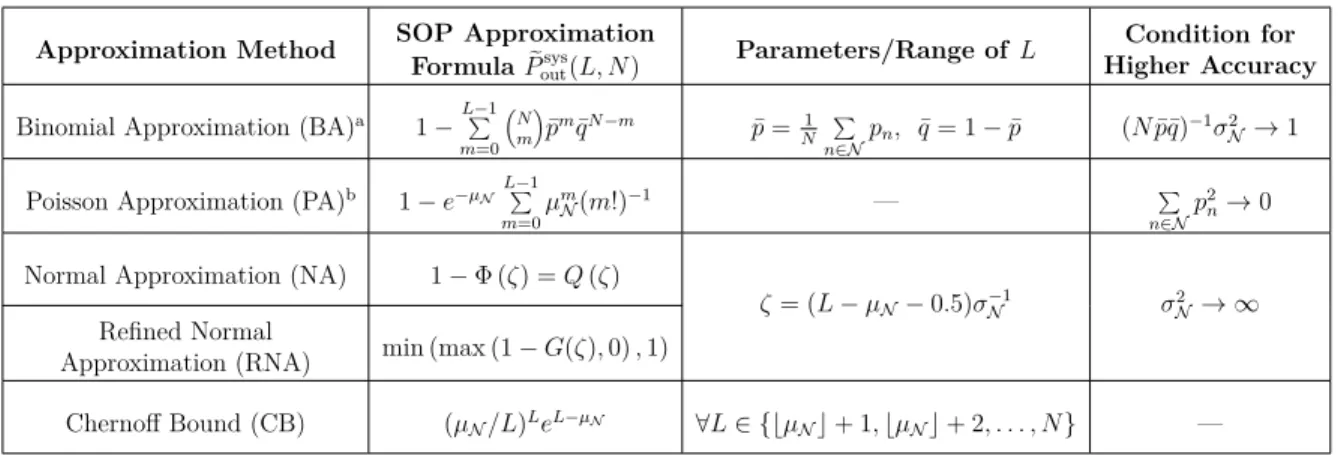
Numerical Results and Discussion
- SOP Analysis
- Performance of Approximation Methods
Conclusion
Appendix-A: Proof of Proposition 7.2
Appendix-B: Proof of Theorem 7.2
Panagopoulos et al., “Long-term rain attenuation probability and site diversity gain prediction formulas,” IEEE Trans. Kourogiorgas et al., “On the earth-space site diversity modeling: A novel physical-mathematical outage prediction model,” IEEE Trans. Karagianniset al., “Multidimensional rain attenuation stochastic dynamic modeling: Application to earth-space diversity systems,” IEEE Trans.
Panagopoulos, “Global optimal selection of earth stations in multi-site satellite systems,” IEEE Wireless Commun. Belfore, "A 𝑂(𝑛(log2𝑛)2) algorithm for computing the reliability of k-out-of-n:G and k-to-l-out-of-n:G systems," IEEE Trans .
General Conclusions and Open Problems
General Conclusions
Also, we have developed global optimization algorithms (B&B and PD), as well as a polynomial-time approximation algorithm with provable performance guarantees. These algorithms can be useful in initial network design, as they can provide significant cost savings in terms of GSS installation. Finally, we have studied in detail the performance of an SGD (LS-SGD) architecture for load sharing in satellite networks, which has been recently proposed in the literature.
Open Problems
Jorswieck, “Efficient global optimal resource allocation in non-orthogonal interference networks,” IEEE Transactions on Signal Processing, vol. Utschick, “Mixed monotonic programming for fast global optimization,” IEEE Transactions on Signal Processing, vol. Debbah, “A global optimal energy-efficient framework for energy control and its efficient implementation in wireless interference networks,” IEEE Transactions on Signal Processing, vol.
Panagopoulos, “Cloud-free line-of-sight prediction modeling for optical satellite communications networks,” IEEE Commun. Arapoglou, “Terrestrial Network Optimization of MEO Optical Satellite Communication Systems,” IEEE Systems Journal, vol.
List of Publications
International Peer-Reviewed Journals
Panagopoulos, “A framework for weighted-sum energy efficiency maximization in wireless networks,” IEEE Wireless Communications Letters, vol.
International Peer-Reviewed Conferences
Book Chapters